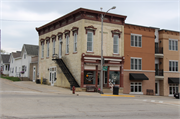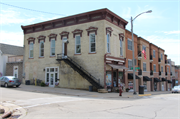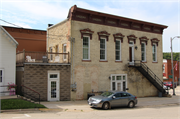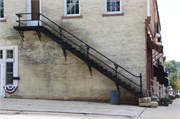Property Record
447 MAIN ST
Architecture and History Inventory
| Historic Name: | Henry S. Magoon Commercial Building |
|---|---|
| Other Name: | Vacant Store/Bank of Darlington |
| Contributing: | |
| Reference Number: | 72894 |
| Location (Address): | 447 MAIN ST |
|---|---|
| County: | Lafayette |
| City: | Darlington |
| Township/Village: | |
| Unincorporated Community: | |
| Town: | |
| Range: | |
| Direction: | |
| Section: | |
| Quarter Section: | |
| Quarter/Quarter Section: |
| Year Built: | 1880 |
|---|---|
| Additions: | |
| Survey Date: | 19822016 |
| Historic Use: | bank/financial institution |
| Architectural Style: | Italianate |
| Structural System: | |
| Wall Material: | Brick |
| Architect: | |
| Other Buildings On Site: | |
| Demolished?: | No |
| Demolished Date: |
| National/State Register Listing Name: | Not listed |
|---|---|
| National Register Listing Date: | |
| State Register Listing Date: |
| Additional Information: | A 'site file' exists for this property. It contains additional information such as correspondence, newspaper clippings, or historical information. It is a public record and may be viewed in person at the Wisconsin Historical Society, State Historic Preservation Office. THIS TWO-STORY FORMER BANK BUILDING WITH A FLAT SLOPING ROOF HAS EAST AND SOUTH ELEVATIONS OF COURSED RANDOM-WIDTH STONE AND A BRICK FACADE AND NORTH ELEVATION. CORBELED PROJECTING WINDOW CORNICES ARCHED IN THE CENTER AND A BRACKETED PROJECTING MAIN CORNICE WITH PANELS OF STYLED FLORAL DESIGN AND A BAND OF DECORATIVE CUT BRICK WORK BELOW THE CORNICE EXTENDING AROUND THE FACADE AND THE NORTH SIDE CHARACTERIZES THIS SUBSTANTIAL STRUCTURE. CAST IRON WORK MADE BY THE UNION FOUNDRY IN ROCKFORD,(D) ILL. INCLUDING PILASTER TRIM AND COLUMNS WITH CORINTHIAN CAPITALS DECORATE THE STORE FRONT AND RECESSED ENTRANCE THAT IS BORDERED BY A SIMPLE METAL CORNICE AT 2ND FLOOR LEVEL. EXTERIOR CAST IRON STAIRS LEAD TO THE 2ND STORY DOOR THAT IS DECORATED WITH A DOOR HOOD SIMILAR TO THE WINDOW HEADS AND A TRANSOM WINDOW. REPORTEDLY, THE OLD BANK VAULT IN THE INTERIOR OF THIS STRUCTURE HAS BEEN RETAINED THROUGH THE YEARS. THIS SUBSTANTIAL COMMERCIAL STRUCTURE IS ARCHITECTURALLY SIGNIFICANT TO THE COMMUNITY BECAUSE IT IS THE BEST REPRESENTATIVE OF 19TH CENTURY ITALIANATE INFLUENCED COMMERCIAL ARCHITECTURE IN DARLINGTON. IN ADDITION, IT IS IMPORTANT BECAUSE IT HAS HELD A KEY CORNER POSITION IN THE STREETSCAPE OF DARLINGTON SINCE THE MID-19TH CENTURY. THIS BUILDING IS HISTORICLALY SIGNIFICANT TO THE COMMERCIAL DEVELOPMENT OF DARLINGTON AS WELL AS ITS ASSOCIATION WITH HENRY S. MAGOON, LAWYER, CONGRESSMAN AND BANKER. BUILT PRIOR TO 1884, IT IS SIGNIFICANT AS THE LAW OFFICES OF HENRY MAGOON AND AS THE THIRD BANKING INSTITUTION BUILT IN DARLINGTON. HENRY S. MAGOON WAS THE SON OF A LAFAYETTE COUNTY PIONEER AND WAS BORN AT MONTICELLO IN 1832. HENRY MAGOON WAS EDUCATED AT MOUNT MORRIS SEMINARY, ILLINOIS, AND WESTERN MILITARY COLLEGE IN KENTUCKY. HE ATTENDED LAW SCHOOL AT FRANKFURT, KENTUCKY IN 1854. FOR TWO YEARS HE HELD THE POSITION AS PROFESSOR OF LANGUAGES AT NASHVILLE UNIVERSITY (1855-1856). IN THE SUMMER OF 1857 HE RETURNED TO SHULLSBURG TO PRACTICE LAW. IN 1859 AND 1860 HE WAS DISTRICT ATTORNEY OF LAFAYETTE COUNTY. IN 1864 HE MOVED HIS LAW OFFICES TO DARLINGTON.(F) FOR THE REST OF HIS LIFE HE PRACTICED LAW IN DARLINGTON, EXCEPT FOR THE LAST TWO. IN 1870 HE WAS ELECTED TO THE U.S. CONGRESS. AFTER HIS TWO YEARS IN CONGRESS HE RETURNED TO DARLINGTON TO PRACTICE LAW.(H) UPON HIS RETURN TO DARLINGTON, IT IS BELIEVED THAT HE OPENED THE BANK OF DARLINGTON, THE THIRD MONETARY INSTITUTION IN DARLINGTON IN THIS BUILDING.(E,I,J) IT, HOWEVER, ONLY REMAINED OPENED FOR ABOUT A PERIOD OF 3-4 YEARS. IN 1887, MAGOON CLOSED UP THE BANK OF DARLINGTON AND MOVED WITH HIS FAMILY TO MILWAUKEE WHERE HE SET UP A LAW PRACTICE. MAGOON DIED TWO YEARS LATER IN MILWAUKEE.(K,L) THIS BUILDING IS HISTORICALLY SIGNIFICANT BECAUSE OF ITS ASSOCIATION WITH MAGOON, AN IMPORTANT FIGURE IN LOCAL, STATE AND NATIONAL POLITICS AND GOVERNMENT. MAGOON'S "BRICK BUILDING" IS ALSO AN IMPORTANT COMMERCIAL STRUCTURE AS A BANKING INSTITUTION AND LAW OFFICE. ACCORDING TO A LOCAL BUSINESSMAN, THE VAULT IS STILL LOCATED IN THE BASEMENT.(A) AFTER MAGOON'S DEATH, THE BUILDING WAS OCCUPIED BY A MILLINERY FOR ABOUT 20 YEARS.(C) ABOUT 1910 IT BECAME MCCARVILLE'S GROCERY, MANAGED BY JOSEPH MCCARVILLE.(A,C) MCCARVILLE WAS IN BUSINESS UNTIL ABOUT 1933 WHEN THE LAST OWNERS, WANDERSCHEID'S PURCHASED THE BUILDING. MIKE WANDERSCHEID AND LATER HIS SON, BOB, WAS IN CHARGE OF THE STORE. THE STORE WAS CLOSED ONLY A FEW YEARS AGO, ABOUT 1976.(B) 2016- "The Magoon Building is located at 447 Main Street, at the corner of Main Street and E. Cornelia Street along the main commercial corridor in the city of Darlington. The commercial area encompasses a three-block stretch of mostly two-story businesses fronting Main Street. The two-and-one-half blocks between Alice Street to the south and just north of Louisa Street to the north comprise the National Register-listed Main Street Historic District. The northern half of the commercial block along Main Street between Louisa Street and Cornelia Street is located outside of the district. On the east side of that block, a row of modern condominiums at 425 Main Street separates the historic district from the Magoon Building. Situated on the southeast corner of Main Street and E. Cornelia Street, the Magoon Building faces west onto Main Street and has a similar setback to surrounding structures, including 425 Main Street, which shares a party wall. The building is separated from the street by a concrete sidewalk. The Magoon Building, constructed c.1880, is a rectangular, two-story, ltalianate commercial structure resting on a stone foundation. It is made of load-bearing limestone, which was quarried locally from the 1860s onward. The west (front) facade and north (side) elevation feature cream brick cladding, which was imported to Darlington from Milwaukee by rail beginning in the 1870s. These street-facing elevations display tall, hood-capped, second-story windows and an ornamental cast-iron storefront; they are capped with a prominent bracketed cornice. This ornamentation represents character-defining features of the ltalianate commercial style. The west facade of the building is dominated by a large, cast-iron storefront made by Union Foundry of Rockford, Illinois. It consists of a raised, recessed, central entry with a double doorway filled with replacement doors and one sidelight. The doorway is flanked by small, modern, one-over-one, double-hung sash windows. To the north and south of the main entry are replacement storefront windows. These are slightly downsized from the original fixed lights, which featured transom windows above the storefront fenestration and double doors. Today, painted wood panels surround the downsized windows. Tall Corinthian columns with fluted bottoms flank the entryway and Corinthian pilasters with fluting and scrollwork stand on either side of the storefront facade. These are each topped by bracket details that border either side of an iron cornice. A retractable awning is mounted above the storefront. The upper story of the facade is dominated by two tall windows with stone sills and elaborate hood molds that feature bracketed tops capped with pediment-like arches. Fenestration consists of replacement, vinyl, six-over-six, double-hung sash. A bricked-in area is located between the two windows at the center of the facade where a small porch with an ornate roof and balustrade was originally located. Above the windows, stepped brickwork leads to a dominant cornice with heavy brackets and a wide overhang. Vegetal ornamentation fills in the panels of the cornice and is overlaid on the brackets. The side (north) elevation displays many features similar to the front (west) facade. These include five replacement, six-over-six windows with elaborate hood molds along the upper story of the elevation; it also has the same decorative cornice with brackets and scrollwork that adorns the building's facade. Additionally, this elevation features a second-story entrance with the same hoodmold as the windows; it consists of a wood door with vinyl storm door and six-light transom. A historic, cast-iron staircase with an ornamental railing and grating leads to the second-story entrance. These stairs rest on a large limestone base that extends from the northwest corner of the building. A modern, vinyl entrance with a glazed door, sidelights, and transom is located on the first story; to the east of this door are two bricked-in areas that may have once been windows or entrances. The side (south) and rear (east) elevations of the Magoon Building feature less ornamentation and are not clad in the decorative brick veneer and cornice that adorn the front (west) facade and side (north) elevation. The south elevation shares a party wall with 425 Main Street. The east elevation consists of limestone laid in rubble courses with replacement windows that display stone lintels and sills. A c.1900, one-story, rusticated concrete block addition extends from this elevation and features a vinyl glazed door entrance on the north elevation and a roof deck with a modern wood balustrade. A second-story door on the east elevation of the building leads to the roof deck over this addition. Interior The structure now houses office space for a real estate broker and the Darlington Chamber of Commerce on the first floor, and an apartment on the second floor. While some rubble-course stone is visible along a segment of wall in the first floor office, overall the space has been significantly altered with modern sheetrock and plaster partition walls, drop ceiling, carpet, and fixtures. A kitchen and bathroom have been added to the first floor. A modern interior staircase leads to the apartment, which has two bedrooms, a bathroom, kitchen, living room, and loft space in the c.1900 addition at the rear." -"Henry S. Magoon Commercial Bldg", WisDOT#5245-02-02, Prepared by Mead & Hunt, Inc., (2016). 2016- "This c.1865, two-story, brick commercial building has a rectangular plan and rests on a stone foundation. The building displays elements of the Italianate style, as seen in the roofline details and fenestration pattern and details on the second story. The flat roof features wide overhanging eaves with brackets and an elaborately detailed cornice on the front (west) facade and side (north) elevation. The brick walls feature a stepped brick detail below the cornice of the front facade. Two tall, narrow, wood, six-over-six, double-hung, sash windows are located on the main facade, and five are visible on the side (north) facade. All windows have a hood detail with brackets and stone sill. Evidence on the main facade suggests that a centrally located window has been bricked in. The first story of the front facade features an elaborate cast-iron storefront, including fluted pilasters at the corners and tapered classical columns framing the central entrance. An awning spans the front facade, flanked by fleur-de-lis detailed pilasters with elaborate Corinthian capitals. Single-pane fixed sash, storefront windows have simple wood surrounds. The main entrance contains a modern metal and glass door and sidelight. A cast-iron staircase located the northwest corner of the main (west) facade provides access to the second story. The building was originally known as the Magoon Building, named for the Lafayette County lawyer who had it built. Henry S. Magoon was born in Monticello Township in 1832. Educated in Kentucky, Magoon returned to Lafayette County to practice law in 1857. Magoon moved his practice from Shullsburg to Darlington in 1864 with the relocation of the county seat, and subsequently commissioned the construction of 447 Main Street, although the exact date is not known. In addition to practicing law, Magoon served in the Wisconsin state assembly and the U.S. Congress. For a short period between 1884 and 1887 Magoon opened the third bank in the city, known as the Bank of Darlington, in this building. In 1887 Magoon closed the bank and moved his practice to Milwaukee, where he passed away in 1889. In subsequent years the building housed a millinery through 1910, and a grocery until 1933." -"STH 23: County Shop Rd to Minerva St", WisDOT#5245-02-02/72 and 5245-02-02/73, Prepared by Mead & Hunt, Inc., (2016). |
|---|---|
| Bibliographic References: | A. KENNETH SCHREITER, INTERVIEW, 1-10-83. B. TERRY MCDONALD, INTERVIEW, 1-10-83. C. SANBORN-PERRIS MAPS, DARLINGTON, 1884, 1889, 1894, 1900, 1908, 1915 AND 1924. D. BUILDING INSCRIPTION. E. "WISCONSIN STATE GAZETTEER," 1886, P. 212. F. C.W. BUTTERFIELD, "HISTORY OF LAFAYETTE COUNTY," 1881, P. 721-722. G. "DICTIONARY OF WISCONSIN BIOGRAPHY," 1960, P. 236. H. "WISCONSIN NECROLOGY," VOL. 2, P. 224. I. "PICK AND GAD," APRIL 17, 1884. J. "DARLINGTON REPUBLICAN," MAY 9, 1884; JAN. 15, 1885. K. IBID., JANUARY 6, 1888. L. IBID., MARCH 8, 1889. (1) Joan Rausch, “An Intensive Architectural and Historical Survey of Mining Communities in portions of Lafayette and Grant Counties, Wisconsin” (Platteville, Wis.: Southwestern Wisconsin Regional Planning Commission, 1983), 70. |
| Wisconsin Architecture and History Inventory, State Historic Preservation Office, Wisconsin Historical Society, Madison, Wisconsin |





